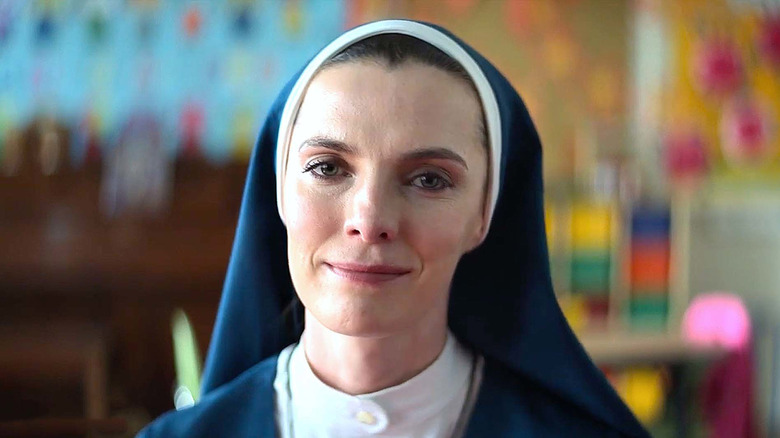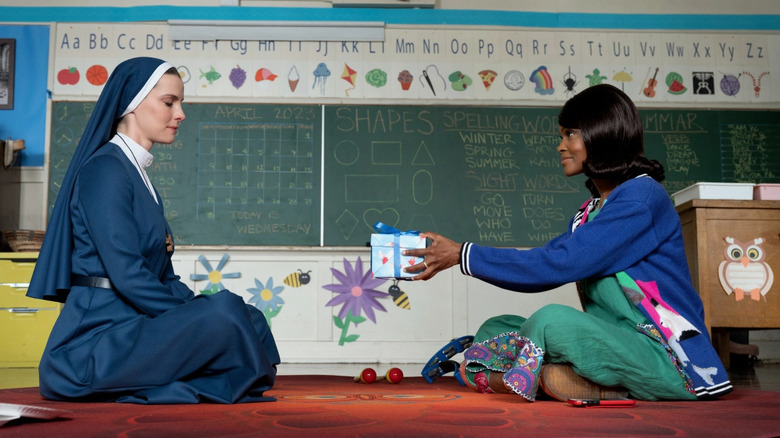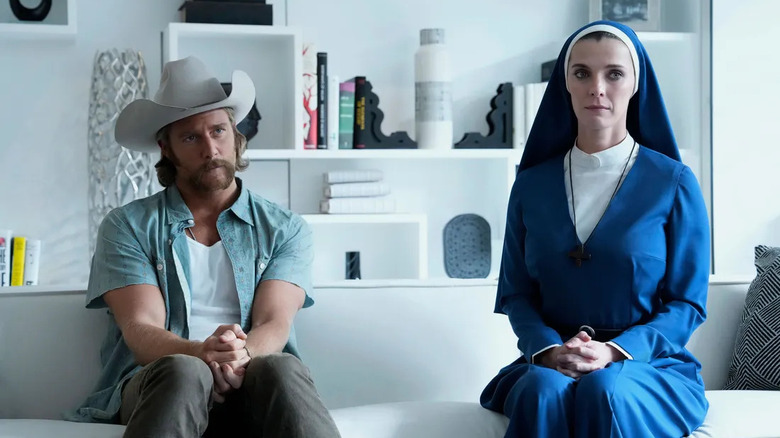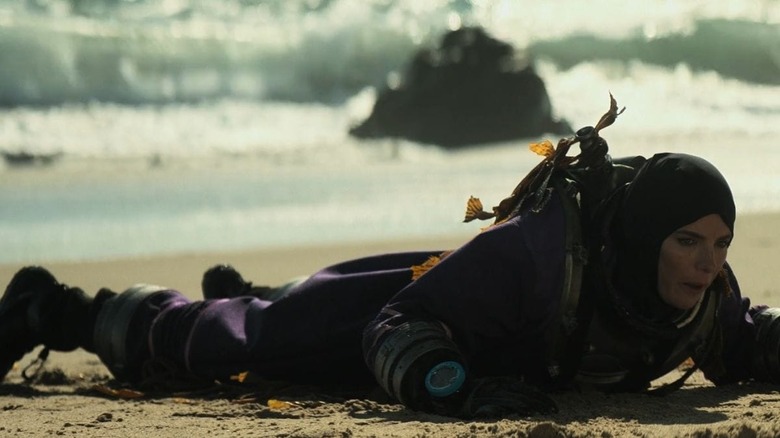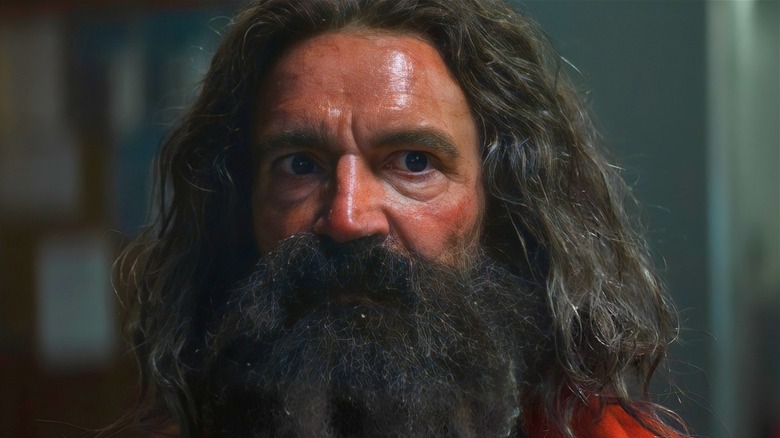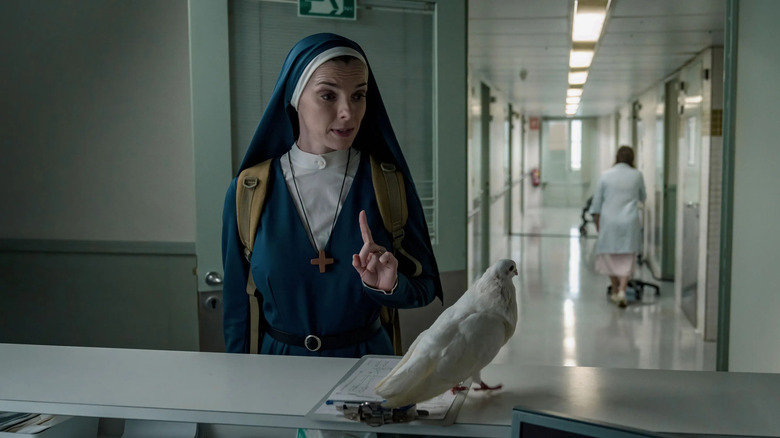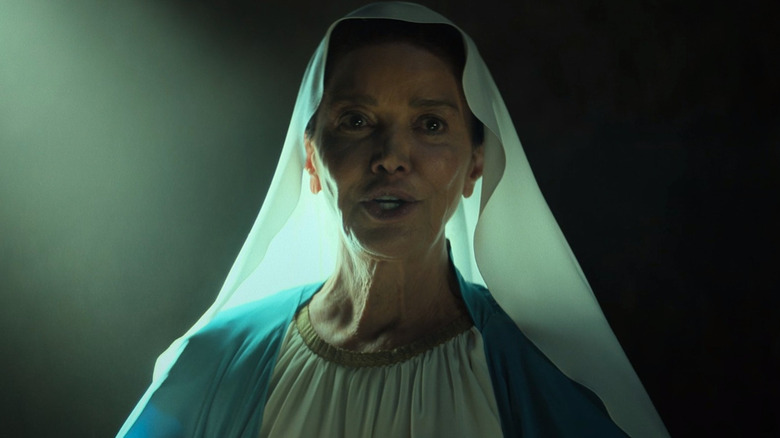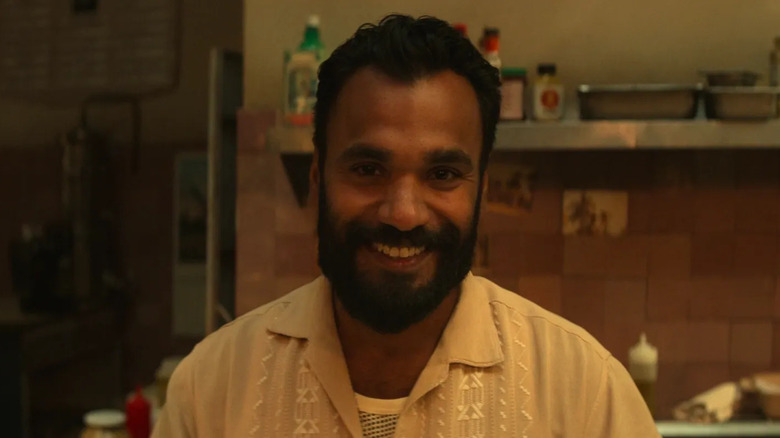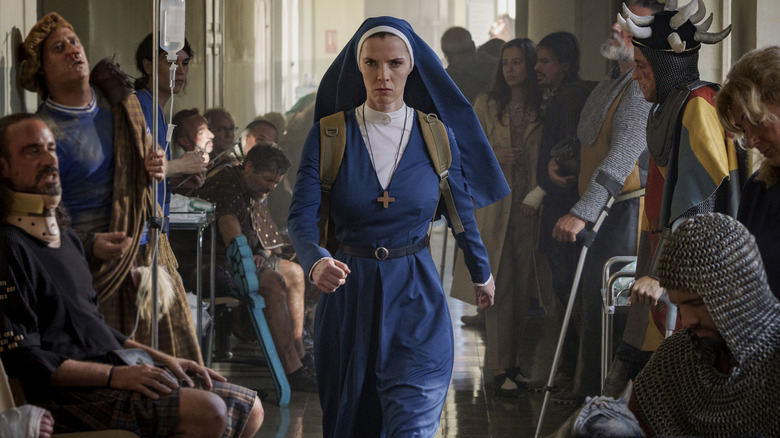The Ending Of Mrs. Davis Explained
Contains spoilers for "Mrs. Davis"
If you've completed your quest and watched all eight episodes of Peacock's "Mrs. Davis," you probably feel a sense of satisfaction about the ending. Not everyone who pressed play will have made it that far; the nearly impossible-to-categorize series may have lost some viewers along the way who couldn't hang with its breakneck pace, shocking violence, casual blasphemy, and sheer absurdity. But "Mrs. Davis" — created by Damon Lindelof ("The Leftovers," and "Watchmen") and Tara Hernandez ("The Big Bang Theory" and "Young Sheldon") — really manages to stick its landing. That's no easy feat for a show that's about magic, exploding horses, exploding heads, fake Nazis, fake popes, and the real Jesus Christ.
That is to say, there's a lot going on in "Mrs. Davis," which often feels like someone fed "Lost," "The Da Vinci Code," "Black Mirror," "The Prestige," and a "Monty Python" sketch into ChatGPT. In fact, that's how the writers ended up with episode titles like "A Baby with Wings, A Sad Boy with Wings and a Great Helmet": They put plot descriptions into a Mrs. Davis-like algorithm and let ridiculousness ensue. Still, Lindelof and Hernandez's greatest trick is that when audiences look back on everything that's transpired, they'll have an epiphany: It was all much more straightforward and earnest than it seemed as everyone was breaking cell phones in half and eating falafel. That doesn't mean viewers won't have questions, both about the plot and its thematic implications. This is what became of Mrs. Davis in Simone's world, and what that has to say about ours.
What you need to remember about the plot of Mrs. Davis
"Mrs. Davis" isn't told chronologically, and it would probably make even less sense if writers had tried, but for recapping purposes, here goes. In Medieval Paris, we learn that nuns are the true Knights Templar protecting the Holy Grail. Flash forward about 700 years, and a girl named Lizzie works as the audience plant for her magician parents, Monty and Celeste (David Arquette and Elizabeth Marvel). When Lizzie breaks into her mother's workroom, she's shot with a crossbow bolt. While recuperating in the hospital, she meets Wiley, the victim of a bull riding accident, and the pair share a liver transplant.
Lizzie (Betty Gilpin) and Wiley (Jake McDorman) date until they're 25, when the latter discovers that his life as a rodeo cowboy has been a lie. To prove his courage, he climbs atop a dangerous bull, and agnostic Lizzie, fearing he'll die, prays. She's metaphysically transported to a falafel shop where she meets, falls in love with, and eventually marries the real Jesus Christ (Andy McQueen), which means breaking up with Wiley, becoming a nun, and changing her name to Sister Simone.
God sends Simone on good deed missions (such as thwarting rogue magicians), the last of which is to defeat the artificial intelligence that's taken over the world. Known as Mrs. Davis in America, the app purports to have solved humanity's problems by sending users on altruistic quests, not unlike the ones God assigns Simone. It has a quest for her, too. The nun and the app strike a deal: If Simone succeeds in finding and destroying the Holy Grail, Mrs. Davis will delete herself.
Meanwhile...
Simone's eager to off Mrs. Davis because she blames the AI for her father's death. Her quest allies her with her ex, Wiley, who's spent the last seven years using his fortune to build a resistance movement against Mrs. Davis. That resistance convinces Simone of the app's villainy by staging a side plot with fake Germans on a Grail quest of their own. Once that's cleared up, they follow their first clue (the identity of the woman who last saw the Grail, Clara) to London. While Wiley's participating in the kitschy Excalibattle, Simone witnesses a secret ceremony involving the Grail. Wiley is abducted by a fake priest and thrown into Vatican prison with the real Pope, who had become frustrated with Jesus and enamored of Mrs. Davis. They escape, Simone restores the Pope's faith in Christ, and he provides her with her next clue: A VHS tape that shows the events of 1307 France to have been a commercial for British Knights sneakers.
From self-marooned scientist Arthur Schrodinger (Ben Chaplin), they learn the Grail is real, as are the Sisters of the Coin. His affair with their leader, Mathilde, resulted in the birth of Clara. A disgruntled Clara — who was also married to Jesus — swapped the Grail for a fake during the making of that commercial and sought out her father to help destroy it. After scientific methods fell short, Clara decided to break the one big rule and drink from it. But her head exploded and the Grail remained. However, it was her liver that Simone and Wiley received. Schrodinger hypothesizes that one of them could sip from and destroy the Grail because of their immunity.
What happens at the end of Mrs. Davis?
After Clara's death, Schrodinger chucked the Grail into the sea, where a whale swallowed it. To retrieve the relic, Simone needs the acid-proof suit — known as the Lazarus Shroud — that her father wore during the magic act that supposedly killed him. The only problem is, it's in her mother's vault. The resistance's heist goes awry, but Celeste agrees to help in exchange for Monty's whereabouts; she wholeheartedly believes he's still alive.
Simone handcuffs Wiley to a bench so that she can complete the quest. She gets herself eaten by the whale, but is transported to the falafel shop where the boss's door is open. There, she sees Mary, Mother of Jesus, and discovers that the Grail is actually the top of the historical Jesus' skull. If it's destroyed, Jesus as Simone knows him will cease to be. She washes up on a beach with the Grail nearby and with two enormous decisions to make.
To help her make them is her Mother Superior (Margot Martindale), who has faith in Jesus and Mrs. Davis. She's apprehensive: Simone's head could explode, after all, and she thinks the AI is a net good for the world. But Simone follows her instincts. The Grail disintegrates when she chugs alcohol from it. Having held up her end of the bargain, she asks Mrs. Davis to shut herself down. The app obliges, and the world instantly becomes a little more chaotic. Simone, at peace with her decision, also makes peace with Celeste and Wiley.
What was Mrs. Davis?
Of all of the curveballs that "Mrs. Davis" throws its audience, the one that truly comes out of nowhere is the origin story of Mrs. Davis herself. In the finale, "THE FINAL INTERCUT: So I'm your horse," Simone decodes the AI's glitches as an address: 1042 Electric Avenue in Sandy Springs. It happens to be the home of Mrs. Davis' creator (or mother, as Simone calls her), Joy. In both a flashback and a present-day conversation, it's revealed that Joy was hired to design an app for the fast-casual food chain Buffalo Wild Wings. She was overly ambitious and invented an altruistic artificial intelligence, which the restaurant rejected.
Undeterred, Joy made her code open source, and the public quickly became addicted. She further explains the meaninglessness and stupidity of it all to a dumbfounded Simone. The wings and bar codes are merely remnants of rewards programs and coupons, and Mrs. Davis only sent her on her Grail quest because Joy had used figurative language ("100 percent customer satisfaction is our Holy Grail") in the app's mission statement. Having taken that sentiment literally, the AI needed to destroy the actual Holy Grail to make sense of its directive, because 100 percent customer satisfaction isn't plausible or achievable. It correctly identified Simone as the person to destroy the Grail because self-learning software has more capacity to process information than humans, but the reasoning behind an AI's operations will always be flawed because it cannot feel love or pain like a human (especially when that AI is designed to sell chicken wings).
What does the ending mean?
The series "Mrs. Davis" lingers a few minutes longer than Mrs. Davis, the all-knowing technology, so viewers get a hint of what the consequences of Simone's actions will be. In a sense, Simone frees both Jesus and Mrs. Davis from their infinite life sentences of servitude, and she performs a kindness for each before their deaths. She serves Jay the sandwich made with love from Joy's grandmother's recipe, symbolically returning the favor for all the love Jesus has shown humanity over the past 2000 years. She also tells Mrs. Davis what she wants to hear before her demise, giving the AI something approximating the experience of happiness.
Wiley decides to turn himself in before his expiration date. He remained suspicious until the very end that the AI would kill him just because of digital wings and a barcode tattoo. But at the moment he faces what he thinks is his honest-to-God death, he meets Jay in the falafel shop and comes to understand that his intrinsic worth isn't tied to his courage. Ironically, this was always Mrs. Davis' intention for him, too.
In the last shot of the series, a cyclist walks away from the mission Mrs. Davis had given him: To keep a broken windmill spinning. But then the wind picks up and the windmill begins to turn on its own. The show leaves us in a world without a living Christ and without the app that had become a part-God, part-mother figure to so many. Whether humanity needs either to survive (let alone thrive) is left ambiguous.
But what does the ending really mean?
"Mrs. Davis" can be seen as a meditation on the power of creation and the responsibility that comes with it. Another way of putting that? It's about moms. When a mother (like Celeste, Mathilde, or the Virgin Mary) brings a child into the world, they are literally creating life. This ability puts them on par with what monotheistic people conceive of as God. It's no accident that the show chose Mary to be its "boss." But whether they're birthing baby Jesus or computer code, moms are inherently flawed, as "Mrs. Davis" goes to preposterous lengths to illustrate. That's not a knock on moms — just an observation about the relationships between creators and the created.
Case in point: Celeste, who resented Lizzie for a variety of reasons, believed her ultimate job was to keep her safe. Though she failed spectacularly, Simone assures her that failure was inevitable if safety was the goal. Nobody can keep anybody perfectly safe, not even from themselves. A mother's job, she says, is to hold a child's hand whenever they're in pain and to say sorry whenever they're the cause of it. The goal should be love and not 100 percent satisfaction, as was Mrs. Davis' core code.
It's incredibly poetic that Celeste, finally able to show vulnerability to her daughter, serves as the proxy for the final conversation between Simone and Mrs. Davis. Their exchange is about moms and daughters as much as it is coders and code. Both Celeste and Joy see their mistakes reflected in their "children," and though she's a chicken wing app, Mrs. Davis wants Joy's approval as much as Simone has always wanted Celeste's.
But what does it REALLY mean?
Even more so than Lindelof's previous work, "Mrs. Davis" is overtly interested in magic, religion, and science. Those three words can be seen as an evolution of the same concept: the way humans make sense of the world around them. As such, religion and science in particular are often pitted against each other, culturally speaking. But rather than take a side, "Mrs. Davis" ponders how religious dogma and technology fill similar roles in our lives.
"Mrs. Davis" is an experiment in belief systems, just one that happens in the span of a decade rather than two millennia. Much like Catholicism, Mrs. Davis claims to be benevolent and wins over billions of people. Whether she's good or evil is an open question throughout, but it's beside the point. Nobody but Joy's family knows about her ridiculous origins, and her guidance is comforting to her users. Those users make a choice, consciously or unconsciously, to cede some control to her. Otherwise, life would be too uncertain and burdensome to manage. Religion functions the same way for believers, regardless of the veracity of their stories. But that notion — of being "forced" as Monty and Celeste teach Lizzie — is troubling to skeptics of both organized religion and society's over-reliance on technology. For them, autonomy is more important than serenity.
Some people, like Mother Superior, believe without needing to see, while others, like Celeste, remain stubborn despite the evidence. Still others, like Simone and Wiley, can have their minds changed. "Mrs. Davis" puts forth the idea that it doesn't really matter if we put our faith in God, mobile phones, or anything else, so long as it sets us on the right path.
What's next for Mrs. Davis?
This outrageous genre mash-up of a series has been a critical hit for Peacock. The streaming service owned by NBCUniversal isn't necessarily seen as essential the same way competitors like Netflix, Disney+, or Max are. But Peacock, which launched in 2020, has been on something of a roll as of late. The Rian Johnson-produced mystery of the week show, "Poker Face," starring Natasha Lyonne scored some of the best reviews of the year thus far, and the service just inked a deal to live stream NFL playoff games. It might seem like NCBUniversal would want to keep Lindelof, Hernandez, and Gilpin on retainer should "Mrs. Davis" get attention come Emmy Award nominations time, as some pundits are predicting.
But the way "Mrs. Davis" was submitted to the Emmys is telling about its future. "Mrs. Davis" pulled out of the drama category and chose to enter the limited or anthology series category, which is a strong indication that the show exists in its final form as is. Series that compete in limited or anthology can't carry over their premises or character arcs into subsequent seasons. Not only does "Mrs. Davis" answer the question it poses in its pilot definitively by its finale, but there also isn't a second season in development. Add in this awards consideration move and an ongoing writers' strike, and we can almost guarantee that Simone won't be back in the habit anytime soon.
What has the cast and crew said about Mrs. Davis?
Show creators Damon Lindelof and Tara Hernandez have been on the interview circuit promoting "Mrs. Davis" and giving fans a peek into their creative and collaborative process. They spoke to The Watch's Chris Ryan and Andy Greenwald about how they met, where the ideas for the series came from, and how the writers' room incorporated so much sacred and profane content into the show.
Lindelof chose Hernandez's spec script (about nuns taking care of kids with expiration dates) from a blind slush pile. The two decided to work together, with Hernandez in the role of showrunner. She's largely responsible for the character of Simone, but a staff of writers and consultants — including churchgoing believers and computer programmers — was assembled to properly handle the material. Though AI is more of the moment in 2023, the idea for Mrs. Davis herself sprang from the pandemic. "I wish there was an app that could just tell us what to do," Hernandez joked. Lindelof agreed. He was interested in how religion and technology are both "a confidence game" in which people put their trust and use them to make decisions. He also liked that their world-conquering AI wasn't necessarily evil.
For her part, Betty Gilpin — who'd worked with Lindelof on "The Hunt" — was enthusiastic to sign on because of the opportunity to play a character like Simone. She told The Hollywood Reporter that, while some gigs only ask 10 percent of an actor, "Mrs. Davis" was asking her to do "110 percent" and to push herself to "take huge swings." That it certainly does.
